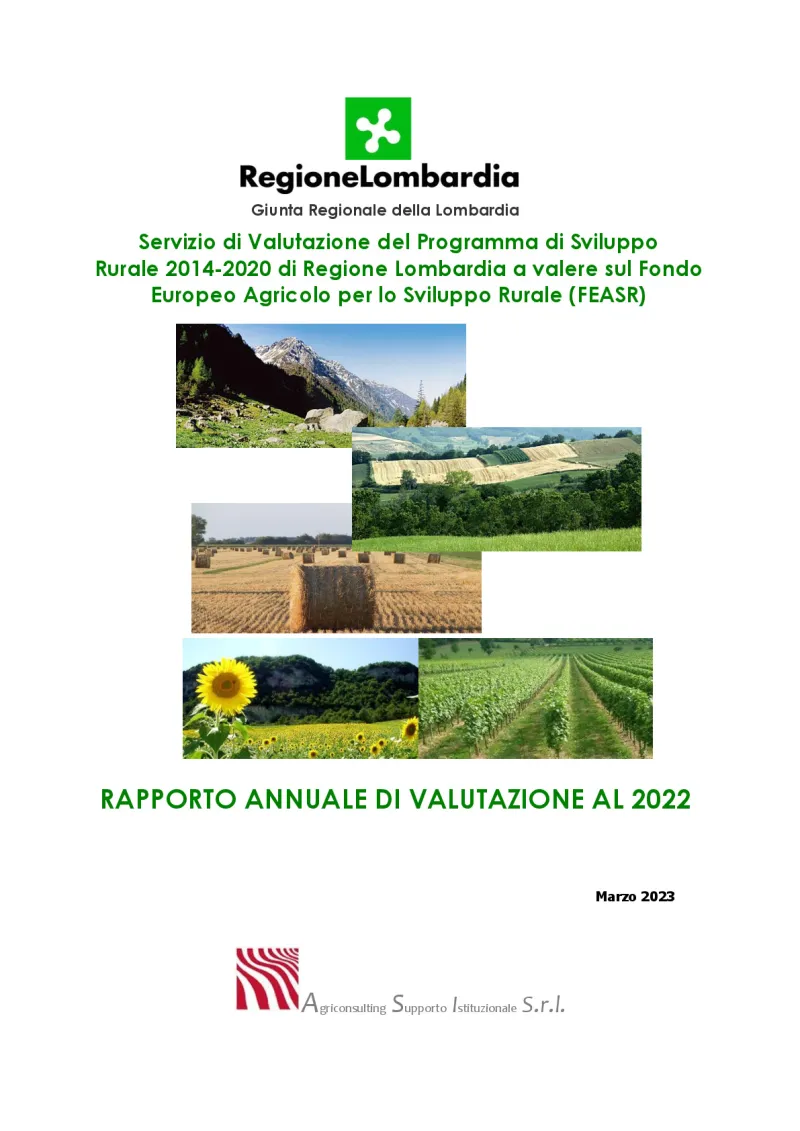2022 annual evaluation report of Lombardia
The report presents the results of the assessment activities conducted in relation to the impact of the Rural Development Programme (RDP) on biodiversity, water quality, water savings, soil and carbon stocks.
- Italy
- 2014-2022
- Environmental impacts

The annual evaluation report is conducted within the framework of the independent evaluation service for the 2014-2022 Lombardia RDP and covers the implementation period up to 2022.
The scope of the evaluation is the assessment of Rural Development Priorities 4 and 5, focusing on the environmental impact of measures related to biodiversity (FA 4A), water quality and water savings (FA 4B and 5A), soil and carbon stocks (4C and 5E).
The methodological approach employed is quantitative, consisting of statistical analysis of secondary data and counterfactual analysis. All RDP operations with environmental impacts were considered.
The sources of the data used include the regional monitoring system (SISCO), documentation and additional information provided by regional officials, the Regional Environmental Authority (REA), the technical assistance service and scientific literature.
Common monitoring and evaluation framework (CMEF) indicators are the main indicator type used. The main evaluation elements considered are represented by the analysis profile, including the dissemination of measures and the extension of areas affected by the interventions, the specific effects of the commitments and the ability of the programme to intervene in relevant priority areas.
With regard to the updating of the data used in the calculations carried out, it should be noted that, while for structural measures it was possible to use the data from the SISCO regional monitoring system updated on 31 December 2022, for area-based measures the data updated on 31 December 2021 were taken into account, as the data for 2022 are currently still being validated.
Concerning the contribution of the RDP to biodiversity, the evaluation concludes that the composition and characteristics of the interventions implemented with RDP support are relevant to regional needs and effective in pursuing the objectives of FA 4A. The total of operations favourable to biodiversity and landscape reaches 22.19% of the regional UAA (utilised agricultural area) and the RDP intervened in more than half (53%) of the regional permanent grasslands and pastures, particularly in mountainous disadvantaged areas, where the RDP assured the maintenance of extensive production systems over an area of 98% of UAA in mountainous disadvantaged.
The RDP is able to selectively intervene in strategic biodiversity and landscape areas, represented by Natura 2000 Network sites, other protected areas, mountain areas and agricultural areas of high nature value. Especially crucial was the RDP's contribution to sheep and goat breeds
Regarding the contribution of the RDP to water quality and water conservation, the commitments made by farmers have led to substantial reductions in nitrogen and phosphorus loads and surpluses on farmland.
Comparing the results obtained through the contribution of the RDP with the regional context (2021), it can be observed that interventions aimed at the efficiency of irrigation systems on farms had an impact on the reduction of water use in the Lombardy agricultural sector by 0.19% (impact indicator I10); this contribution is mainly related to the efficiency of collective-type irrigation
Concerning the contribution of the RDP to Soil protection and carbon stocks, the RDP has supported production processes and agricultural and forestry practices that promote improved soil management over an area of 18% of the regional UAA. The operations that contribute most to this result are conservation agriculture (Operation 10.1.04) and organic farming (Measure 11), which together cover 105 596 hectares. The RDP in the period 2016-2021 has contributed to increasing by 1.07% the content of organic carbon stored in the soil of the agricultural areas concerned, improving its structure and function
Concerning the reduction of greenhouse gas and ammonia emissions, it is estimated that the RDP has resulted in a reduction of 23 650 t CO2eq/year in GHG emissions and 1 595 t NH3/year in ammonia emissions. The important contribution assumed by Operation 10.1.01 (integrated production), both in terms of unit reductions and the size of the areas involved, is also highlighted. The impact of the RDP on reducing GHG emissions can be estimated at a total of 157 658 t/year of CO2eq, a value that represents 2% of the total emissions of the agricultural macro-sector in Lombardy in 2019.
Author(s)
Agriconsulting Supporto Istituzionale S.r.l.